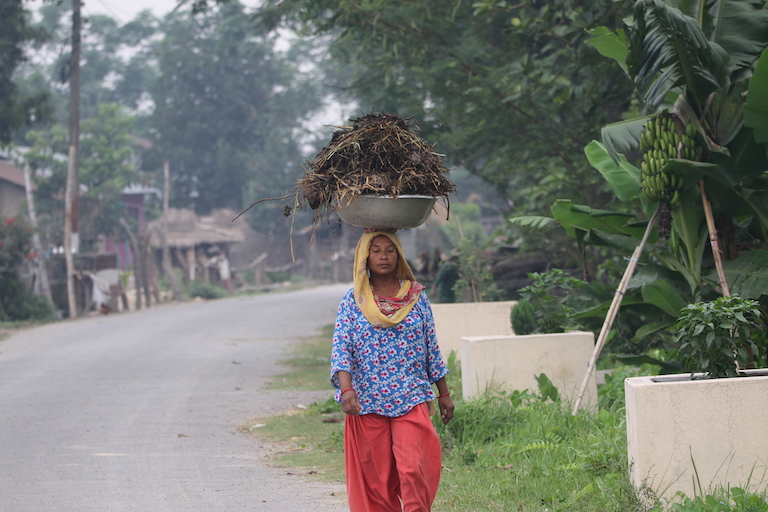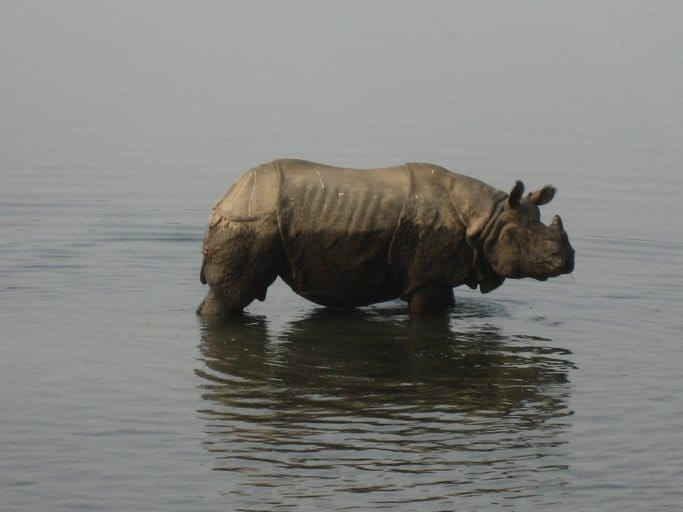- A high prevalence of tapeworms and other parasites in the greater one-horned rhinos of Chitwan National Park in Nepal has raised concerns about the threatened species.
- A new study suggests the problem is an unintended consequence of decades of successful rhino conservation, leading to a growing number of the animals roaming outside the park and into areas also frequented by livestock.
- A similar high prevalence of gastrointestinal parasites has also been recorded in India’s Kaziranga National Park.
- The authors of the new study emphasize that the parasites don’t kill the rhinos, although they may affect their metabolism or cause disease during periods of stress.
KATHMANDU — Decades ago, rhinos in Nepal’s Chitwan National Park were so rare that tourists who ventured on safaris in hopes of a sighting often returned disappointed.
Since then, the park’s population of greater one-horned rhinos (Rhinoceros unicornis) has boomed, from around 100 in the 1970s to 694 in the 2021 census.
The animals are now so widespread that they can even be spotted in the buffer zones outside the park, in fields also frequented by livestock such as cows and buffalos.
While the growing number and range of the rhinos have been hailed as a conservation success, they’ve also had an unintended consequence: the increased interactions between rhinos and domestic livestock may be aiding the spread of harmful gastrointestinal parasites, a recent study suggests.

The study, published in the journal Annals of Parasitology, shows a high prevalence of parasite eggs and larvae, including roundworms and tapeworms, in the Chitwan rhinos.
“We found the prevalence of 13 different genera of parasites belonging to four different classes,” lead author Prashamsa Paudel, from Tribhuvan University in Kathmandu, told Mongabay. “We hadn’t expected to find so many types of parasites in rhinos in Chitwan.”
Nepali authorities, lauded for winning the fight against poachers and increasing the country’s rhino population to unprecedented numbers, have been worried that threats to the species persist as the animals continue to die in large numbers from non-human-related causes.
Between 2004 and 2014, 81 rhinos died from these causes, which ranging from old age to fighting, or an average of around seven per year. That number has since shot up: From 2015 to 2017, 60 such deaths were recorded, an average of 20 per year. Forty-three rhinos died in the 2018-19 fiscal year, and 26 in the 2019-20 fiscal year. Thirty-two rhinos have died from non-human-related causes so far this fiscal year, which began in July 2021. Various hypotheses have been presented to explain what’s going on, but none have been conclusive.
For their study, Paudel and her colleagues analyzed 100 samples of rhino dung. They found one or more parasites in 91 of the samples; 87 samples contained nematodes (roundworms), 45 contained trematodes (flatworms), 16 contained cestodes (tapeworms) and nine protozoa (single-cell parasites).
“The parasites we found affect the alimentary canal of the rhinos. Although they don’t kill the animals, they might have some effects on their metabolism and may cause disease under stress conditions,” Paudel said.
A parasitic infection among Sumatran rhinos at the Sungai Dusun Rhino Conservation Centre in Malaysia in 2003 serves as a cautionary tale for conservationists not to take the issue lightly. Back then, Peninsular Malaysia’s entire captive population of five Sumatran rhinos (Dicerorhinus sumatrensis) died in the space of three weeks. Autopsies revealed abundant bacterial growth pointing to infections caused by E. coli and K. pneumoniae, bacteria found in humans as well as animals, and the presence of the blood-borne trypanosome (Trypanosoma evansi) parasite. A herd of buffalo that shared a fence with the center was believed to be the reservoir of the infection.
“We have observed that gastrointestinal parasites have become common in greater one-horned rhinos,” said Amir Sadaula, a veterinarian with the National Trust for Nature Conservation, Chitwan, a semi-governmental body that works closely with park authorities. “In most of the autopsies we have done on rhinos, we have found the prevalence of parasites. In the wild, we don’t administer medication against these parasites.”
A study on the greater one-horned rhinos of Kaziranga National Park in India corroborates Sadaula’s findings. The study, published in 2018, found that parasite eggs found in wild rhinos were primarily of trematodes, nematodes and cestodes. All of the samples taken contained the trematode eggs, 94% contained nematode eggs, and 56% cestode eggs.

“The study shows that [we] need a better understanding of where the parasites are coming from and what can be done about it,” said parasitologist Janak Raj Subedi from Tribhuvan University, a co-author of the Chitwan study.
“As the [recent] study only identifies the parasites at the genus level, we need a detailed molecular study to identify the species involved. For that we need resources and funding,” he added. The Kaziranga study also recommended the same.
Sadaula said identifying the parasite species involved would help researchers understand if and how parasites are circulating from wild animals to cattle or vice versa. “That would help us identify ways to prevent the spread of parasites,” he said.
The large areas in buffer-zone community forests that are frequented by both domestic livestock and wildlife could be ground zero for these transmissions, Paudel said.
“This could help the transmission of parasites,” she said. “Therefore, we need to take special measures to prevent this from happening, while further molecular research goes on.”
Banner Image: A greater one-horned rhino in Nepal’s Chitwan. Image by bobosh_t via Flickr CC BY-SA 2 .
Feedback: Use this form to send a message to the author of this post. If you want to post a public comment, you can do that at the bottom of the page.
Citations:
Paudel, P., Subedi, J. R., & Pathak, A. (2022). Prevalence of gastrointestinal parasites among greater one-horned rhino in Chitwan National Park, Nepal. Annals of Parasitology, 68(1), 159-167. doi:10.17420/ap6801.420
O’Connor, L., Choudhury, B., Ali, S., Bull, K., & Morgan, E. (2018). A survey of gastrointestinal parasites of wild and orphan greater one-horned rhino (Rhinoceros unicornis) in Kaziranga National Park, Assam, India. Journal of Zoo and Wildlife Medicine, 49(4), 1051-1053. doi:10.1638/2018-0051.1














